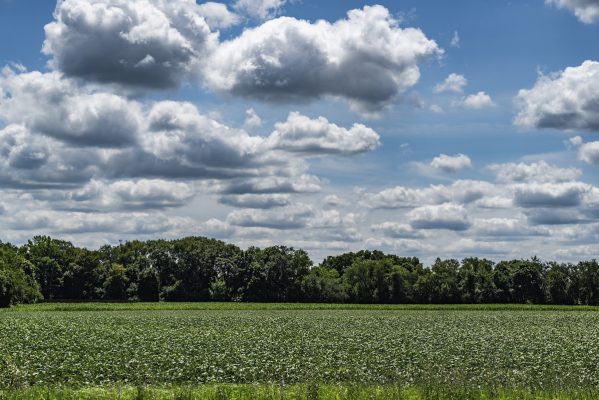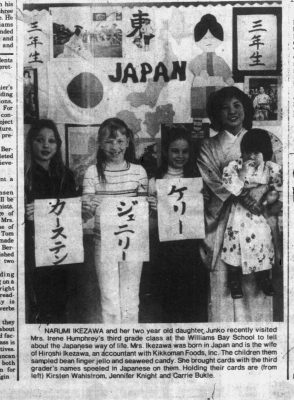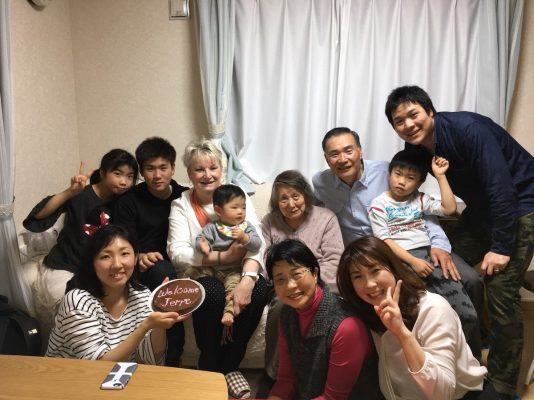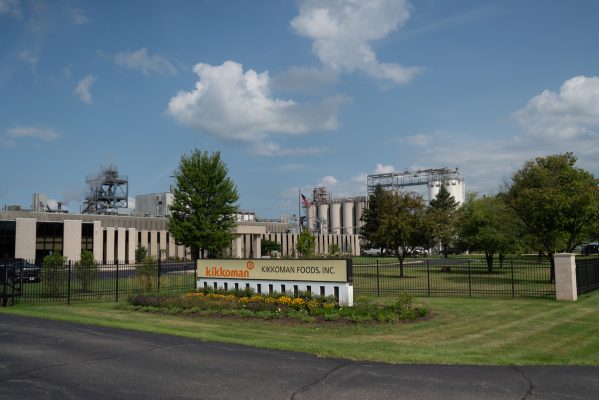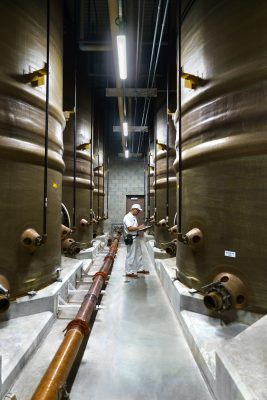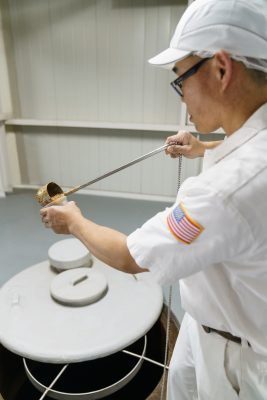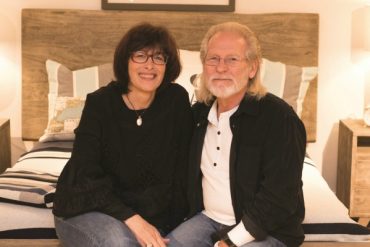By Anne Morrissy | Photos courtesy Kikkoman Foods Inc,
In March of 2018, longtime Williams Bay resident Jerre Burrough embarked on a once-in-a-lifetime adventure. For the past 35 years, she and her husband, Dave, had owned Burrough’s Floor and Wall Coverings, and their busy schedule had never allowed much time for international travel. But now, as she approached retirement, Jerre had a trip she wanted to take: she wanted to visit Japan. The idea had begun germinating many years ago, after a Japanese family had moved into a house behind the Burroughs’ house on Cherry Street in 1979. Hiroshi and Narumi Ikezawa had relocated to the area two years earlier to join a group of about 15 Japanese families, all of whom signed up for five-year contracts in Walworth County to help establish and run the first Kikkoman Foods Inc. plant outside of Japan.
After the Ikezawas moved in, the two neighbors, Jerre and Narumi, found they had a lot in common, and quickly formed a friendship. Both had daughters that were born just a few months earlier, so they spent a lot of time together in their adjoining backyards, or walking together to the beach to spend the day by the water with their children. Narumi would invite Jerre over for lunch, introducing her to Japanese customs and food. As their girls got older, they would play together, and soon became fast friends, too.
Then in 1982, when her husband’s five-year contract was up, Narumi and her family returned to Japan. But Jerre and Narumi stayed in touch throughout the years, sending letters about once a month, sharing the news of their lives across a span of 6,200 miles and 14 time zones. Finally, in 2018, Jerre boarded a plane to see her friend’s homeland, which she had heard so much about. Decades after they first met as neighbors in Williams Bay, Narumi was waiting at Tokyo’s Narita International Airport to meet her. This year, in a fitting parallel to this long friendship, Kikkoman is celebrating 50 years in Walworth County.
RESPECT FOR TRADITION
In the early 1970s, Kikkoman’s decision to open a plant in Walworth was just the latest development in the company’s very long history. The story of Kikkoman began in a very different time and place: Noda, Japan, in the 17th century. Today, Noda is a picturesque suburb about 20 miles northwest of Tokyo. But in the 1600s, Noda was a rural farming community in Japan’s Honshu Province, and its location between the Edo and Tone rivers was transforming the area into an important river port. The village was also located on the Kanto plain, where the growing conditions proved ideal to grow soybeans and wheat, two of just four ingredients necessary to produce soy sauce. (Salt and clean water are the other two.)
In the late 1600s, capitalizing on this location, eight Noda families — the Mogi, Takanashi and Horikiri families among them — began brewing soy sauce and selling their product throughout Japan. More than two centuries later, in 1917, these families began selling and marketing their products under a single name, Kikkoman, and began exporting their product to the United States. Kikkoman soy sauce quickly became a fixture in the U.S., thanks in part to the popular new Chinese-food restaurants that were popping up around the country.
However, it was the U.S. occupation of Japan following World War II that expanded the American demand for soy sauce even further, as American servicemen and women, as well as journalists, educators and volunteers, developed a taste for Japanese cuisine and inspired a rise in its popularity stateside. In 1957, Kikkoman opened an office in San Francisco to oversee marketing and distribution of its soy sauce in the United States. Following this increased global demand, in 1964, the Noda-based company officially changed its name to Kikkoman Corporation.
CONSTANT INNOVATION: AMERICAN EXPANSION
By the early 1970s, international demand for Kikkoman soy sauce was so steady that the company’s leaders decided to take a leap of faith: they would borrow money to build the first Kikkoman plant outside of Japan, and become one of the first Japanese corporations to establish a major production facility in the United States. Inside the company, a committee was tasked with investigating possible locations for the American plant, working with an American business consulting firm. Current honorary CEO and Chairman of the Board Yuzaburo Mogi was a member of that committee. He says they started with a list of more than 200 locations, before narrowing their choices to about 60 sites across Wisconsin and Illinois.
Ultimately, Mogi says the committee selected Walworth for its plentiful agricultural supply of the four soy sauce ingredients, and its central location, which made shipping fast and efficient. But he says the most important factor in choosing Walworth was the people of Walworth County: on visits to the area, the committee perceived the local workforce to be committed and hard- working, and welcoming to the idea of living and working alongside Japanese employees. “We chose Walworth because of the circumstances and atmosphere,” Mogi explains. “At that time, this area was a farming area, and I understood that people in Wisconsin, especially in this area, they are hard-working people, so we could expect high productivity. Also, people around here are very friendly — they welcomed us. And they had a great interest in developing the economy, from agriculture to industry.”
Once Walworth was selected as the site of the new plant, the company began partnering with local and regional farmers to ensure a plentiful supply of soybeans and wheat. They also began hiring and training American employees in the Japanese art of making soy sauce. Kikkoman employs a traditional Japanese brewing process called honjozo, to make a naturally and sustainably brewed soy sauce. This was the first time Americans would be involved in the process. The 147,000-square-foot plant opened in Walworth in 1973, with 15 Japanese employees and about 35 American employees. The era of Kikkoman’s American operations had begun.
HARMONY AND EFFICIENCY
To this day, one of Kikkoman’s core corporate values is to give back to the communities in which the company operates. The plant’s grand opening in June, 1973, included a Shinto blessing of the new building and a community-wide celebration; the company published an open invitation for community members to attend. Thousands of local residents took part in the opening- day festivities, which also included traditional Japanese folk dancing, singing and Taiko drumming, as well as tours of the factory.
To further contribute to the community, almost as soon as the plant opened, current honorary CEO Mogi (then the company’s vice president) attended the Governor’s Conference on Business Development, and began a long- standing collaboration between the Midwest Governors’ Association and the Japanese business community that continues to this day. The company also introduced a spirit of cultural exchange through the five local high schools, offering scholarships for two students each summer to live with a family in Japan for eight weeks while studying the language and culture. The program, which began in 1978, continues to send Walworth County students to Japan today.
More recently, Kikkoman began working with representatives from the University of Wisconsin to study and develop sustainable agricultural practices and freshwater conservation efforts. In June, Mogi announced Kikkoman’s gift of two large grants to UW institutions: a $2 million grant to the University of Wisconsin-Milwaukee to support the construction of the School of Freshwater Sciences’ research vessel Maggi Sue and a $3 million grant to the University of Wisconsin- Madison’s College of Agricultural & Life Sciences. “Kikkoman’s arrival here launched a partnership with Wisconsin that has been long and fruitful,” says Dr. Jennifer Mnookin, chancellor of UW-Madison.
CONTINUING LEGACY
Today, following a $100 million expansion that began in 2003, the Kikkoman plant in Walworth operates seven days a week and employs over 200 people, most of them local employees working alongside a handful of Japanese employees. It is the largest naturally brewed soy sauce production facility in the world. And while soy sauce is still the main product brewed at the Walworth plant, globally the company produces 40 liquid and powder products, including teriyaki sauce, hoisin sauce and sweet-and- sour sauce, among many others. In 1998, Kikkoman added a second U.S. production facility in California, and today, the company operates a total of 11 plants around the world in North America, Europe, South America and Asia. Since first opening 50 years ago, the Walworth plant’s production has grown 30-fold. “For the past 50 years, our Walworth plant has been the model for Kikkoman’s worldwide expansion,” Mogi says.
The opening of the Kikkoman plant in Walworth in 1973 began a period of friendship and cultural exchange between Japan and Walworth County that continues to this day. In June, a delegation of more than 700 Japanese businesspeople and journalists arrived at Grand Geneva Resort & Spa to celebrate the 50th anniversary of Kikkoman Walworth and attend an economic summit examining shared business opportunities between Wisconsin, the greater United States and Japan. The summit was attended by Wisconsin Gov. Tony Evers, Mogi, and many state and local business leaders. At the event, Evers congratulated Mogi on his company’s anniversary at the Walworth plant, and declared June 9, 2023, to be “Kikkoman Day” in Wisconsin.
For Narumi Ikezawa and Jerre Burrough, the effects of Kikkoman’s decision to open the Walworth plant in 1973 are much more personal and have reverberated across a lifetime. “We’ve been wonderful friends for so many years now,” Burrough says, adding that she never guessed when they first met that she would one day be lucky enough to visit Japan.
Ikezawa similarly treasures the many deep and lasting friendships she made in Walworth County. “When Kikkoman asked us to return to Japan, I was very sad,” she remembers. “From young to the elderly, I was surrounded with friends. We were blessed to spend [a] wonderful time [in the U.S.] thanks to the people. Jerre and her family are so close [to ours] that I do not know how I can put it into words. She has been a symbol of friendship and love between me and [the] people in Williams Bay … [we have] so [many] friends there that were wonderful to us.”

